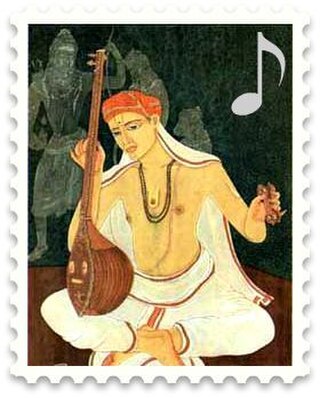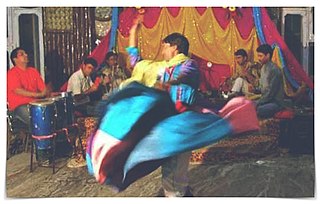
Polyphony is a type of musical texture consisting of two or more simultaneous lines of independent melody, as opposed to a musical texture with just one voice (monophony) or a texture with one dominant melodic voice accompanied by chords (homophony).

"Jana Gana Mana" is the national anthem of the Republic of India. It was originally composed as Bharoto Bhagyo Bidhata in Bengali by polymath Rabindranath Tagore on 11 December 1911. The first stanza of the song Bharoto Bhagyo Bidhata was adopted by the Constituent Assembly of India as the National Anthem on 24 January 1950. A formal rendition of the national anthem takes approximately 52 seconds. A shortened version consisting of the first and last lines is also staged occasionally. It was first publicly sung on 27 December 1911 at the Calcutta Session of the Indian National Congress.

Carnatic music, known as Karnāṭaka saṃgīta or Karnāṭaka saṅgītam in the South Indian languages, is a system of music commonly associated with South India, including the modern Indian states of Andhra Pradesh, Karnataka, Kerala, Tamil Nadu and Telangana. It is one of two main subgenres of Indian classical music that evolved from ancient Hindu texts and traditions, particularly the Samaveda. The other subgenre being Hindustani music, which emerged as a distinct form because of Persian or Islamic influences from Northern India. The main emphasis in Carnatic music is on vocal music; most compositions are written to be sung, and even when played on instruments, they are meant to be performed in gāyaki (singing) style.

Bhajan refers to any devotional song with a religious theme or spiritual ideas, specifically among Indian religions, in any language. The term bhajanam means reverence and originates from the root word bhaj, which means to revere, as in 'Bhaja Govindam' . The term bhajana also means sharing.

The music of Afghanistan comprises many varieties of classical music, folk music, and modern popular music. Afghanistan has a rich musical heritage and features a mix of Persian melodies, Indian compositional principles, and sounds from ethnic groups such as the Pashtuns, Tajiks and Hazaras. Instruments used range from Indian tablas to long-necked lutes. Afghanistan's classical music is closely related to Hindustani classical music while sourcing much of its lyrics directly from classical Persian poetry such as Mawlana Balkhi (Rumi) and the Iranian tradition indigenous to central Asia. Lyrics throughout most of Afghanistan are typically in Dari (Persian) and Pashto. The multi-ethnic city of Kabul has long been the regional cultural capital, but outsiders have tended to focus on the city of Herat, which is home to traditions more closely related to Iranian music than in the rest of the country.

The Kashmiri Pandits are a group of Kashmiri Hindus and a part of the larger Saraswat Brahmin community of India. They belong to the Pancha Gauda Brahmin group from the Kashmir Valley, located within the Indian union territory of Jammu and Kashmir. Kashmiri Pandits are Hindu Kashmiris native to the Kashmir Valley, and the only remaining Hindu Kashmiris after the large-scale of conversion of the Valley's population to Islam during the medieval times. Prompted by the growth of Islamic militancy in the valley, large numbers left in the exodus of the 1990s. Even so, small numbers remain.

Pansori is a Korean genre of musical storytelling performed by a singer and a drummer.
Blackfoot music is the music of the Blackfoot people. Singing predominates and was accompanied only by percussion.

The Rai are ethnolinguistic groups belonging to the Kirat family and primarily Tibeto-Burman linguistic ethnicity. They mainly reside in the eastern parts of Nepal, the Indian states of Sikkim, West Bengal and in southwestern Bhutan.

Music of Jammu and Kashmir reflects a rich musical heritage and cultural legacy of the Indian-administered union territory of Jammu and Kashmir. Two different regions of Jammu and Kashmir consists the Jammu region and Kashmir Valley. Music of Kashmir Valley has influences of Central Asian music while music from Jammu region is similar to that of other regions of North India.

Music of Punjab reflects the traditions of the Punjab region of the Indian subcontinent, associated with Punjabi language. Punjab is currently divided into two parts: East Punjab, in India, and West Punjab, the most populous province of Pakistan. The Punjab has diverse styles of music, ranging from folk and Sufi to classical, notably the Patiala gharana. Contemporary Punjabi music has tended to include more modern hip-hop and R&B sounds. While this style of music is obviously most popular in Punjab, it has seen popularity across the subcontinent and areas with large Punjabi diaspora populations, such as Canada, the United Kingdom, and the United States.

Chhattisgarh is a state of India with strong tribal traditions of music and dance. The state of Chhattisgarh is best known for its deep roots in folk music, which originated from its long history of tribal involvement.

The Seri or Comcaac people are an indigenous group of the Mexican state of Sonora. The majority reside on the Seri communal property, in the towns of Punta Chueca and El Desemboque on the mainland coast of the Gulf of California. Tiburón Island (Tahejöc) and San Esteban Island were also part of their traditional territory. They maintain an intimate relationship with both the sea and the land. They are one of the ethnic groups of Mexico that has most strongly maintained their language and culture throughout the years after contact with Spanish and Mexican cultures.
"Raghupati Raghava Raja Ram" is a bhajan widely popularised by Mahatma Gandhi and set to tune by Vishnu Digambar Paluskar in Raga Mishra Gara.
"I Protest" is a rap song by a Kashmiri singer MC Kash, that he sang in 2010. The song that is about the 2010 Kashmir Uprising and Human rights abuses in Kashmir and failures by Kashmiri politicians including the separatists. It became an immediate hit in the valley and outside. The song was sung during protests. The studio where the song was recorded was raided by the local police after the song was released and the staff was questioned about involvement of any separatist leader. Kash, who was emotionally disturbed by the deaths of youth, including his friend, in the unrest, wrote the song. According to Kash, he wrote this in English to spread awareness about the situation in Kashmir. Kash faced hard time in recording his songs after this song was released as most of the studios denied facilitating him and he felt considerable pressure to stop raising such issues in his songs after people close to him showed concern about his security.

Maithili Music is one of the most ancient types of music in the Indian subcontinent. It originated from Mithila, a geographical and cultural region of the Indian subcontinent bounded by the Mahananda River in the east, the Ganges in the south, the Gandaki River in the west and by the foothills of the Himalayas in the north. It comprises certain parts of Bihar and Jharkhand of India and adjoining districts of the eastern Terai of Nepal. No one knows exactly when Maithili Music came into existence, probably due to the length of its history, but its age indicates that it might have helped other music develop and flourish in India and Nepal.It is believed that many new types of music forms have been sprouted from Maithili music as it is believed to be the oldest form of music is South Asia. Maithili music are played during a variety of ritual occasions, and it is believed that some of the most melodic music among them. The music was generally based on the daily life of a common man which made it relatable to the audience and hence accepted on mass. Although Maithili music is usually played by classical instruments, it has been modernized and now uses various modern instruments. Some significant contributors to this music style are Maha Kavi Vidyapati Thakur, Udit Narayan Jha, Sharda Sinha, Kunj Bihari Mishra, Haridwar Prasad Khandelwal, Dr. Shanti Jain, Rajni Pallavi, Poonam Mishra, Ranjana Jha and many more.

Bacha Nagma is one of the major folk dance forms found in the Kashmir valley. It is also referred to as Bacha Gyavaun in certain parts of Kashmir. Afghans of Kabul are credited with the parentage of this dance. It is a derivative of the Hafiza Nagma. During the Bacha Nagma, a teenaged boy dressed as a girl dancer, who is trained in the Hafiza style of dancing sings Kashmiri Ballad and dances. This dance is popular in the villages, mainly at the harvest time. It is also popular for being performed in social gatherings and parties by young boys who disguise themselves as women in long skirts. Bacha Nagma is common in Kashmir during wedding celebrations and when the wedding processions are taken out on boats on the Jhelum river. This dance form is much appreciated and has the ability to engage large audiences. It is accompanied by instruments like rabab, sarangi, and drums. It involves quick spinning movements just like in the Hafiza dance form and some may even resemble those of kathak. The song-dance proceeding is known as Bach Nagma Jashan - Kid Dancer's Celebration. The dancer is known as The Bacha - the Kid - usually a thin and graceful boy/man who dances, sometimes comically, is always attired like a woman in a multi-colored frock-like dress.
Ladishah is a storytelling musical genre originated in Jammu and Kashmir with its roots in traditional and humorous folk singing originally sung by minstrels while locally wondering from one place to another. It is usually sung in Kashmiri language to express anguish or to entertain people in a rhythmic form primarily revolves around political, social and cultural issues in the form of ballad or melodious satire. It is identified when an entertainer raises their concerns in the form of humorous and melody singing without a voice break at some occurrences. It is sung with a musical instrument called dhukar, a traditional instrument consisting of two metal rods. Sometimes, an artist sings without a musical instrument.
Mukhtar Begum was a Pakistani classical, ghazal singer and actress. She was known as The Queen of Music for singing songs in films and on radio. She worked in Hindi, Punjabi and Urdu films and was known for her roles in films Hathili Dulhan, Ali Baba 40 Chor, Nala Damayanti, Dil ki Pyas, Ankh ka Nasha, Muflis Ashiq and Chatra Bakavali.












